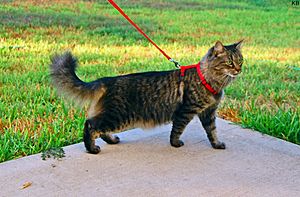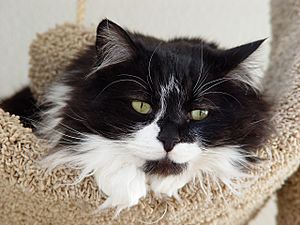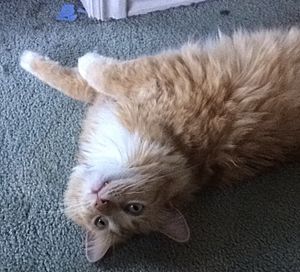Domestic long-haired cat facts for kids
Quick facts for kids Domestic long-haired cat |
|
|---|---|

A brown mackerel tabby domestic long-haired cat
|
|
| Other names |
|
| Common nicknames | Long-haired moggie |
| Variety status | Not recognised as a standardised breed by any major breed registry. |
| Notes | |
|
Like the domestic short-haired cat, this is not a breed, but a non-breed classification of mixed-breed cats.
|
|
| Domestic cat (Felis catus) | |
A domestic long-haired cat is a type of cat that has long, flowing fur. Unlike specific cat breeds, these cats are a mix of different cat ancestries. This means they don't belong to any official, recognized breed.
You might hear them called other names, like long-haired house cat or, in the United Kingdom, a long-haired moggie. They are very popular, especially in the United States, where they are the second most common type of cat after the domestic short-haired cat.
Even though they aren't a specific breed, domestic long-haired cats can still be classified by groups like veterinarians or animal shelters. They might be called "Domestic Longhair" (DLH) or "House Cat, Longhair" (HCL). Some mixed-breed cats even get to enter special "Household Pet" divisions in cat shows! Rules for these shows can vary, but many allow any healthy cat to participate.
What do they look like?
Domestic long-haired cats come in all sorts of colors and patterns. You can find them as tabby, tortoiseshell, bi-colored, or even smoke colored. Their fur can be quite long, sometimes up to six inches!
Many of these cats have a fluffy mane around their neck, similar to a Maine Coon cat. They can also have cute tufts of fur on their toes and inside their ears.

Because their fur is so long, some domestic long-haired cats need help keeping it neat. Their human owners often have to groom them regularly to prevent their fur from getting tangled or matted.
A great thing about these cats is that they are generally very healthy. Since they come from a wide mix of cat genes, they usually don't have the same inherited health problems that some specific cat breeds might have.
Where did they come from?
Long-haired cats seem to have first appeared in Western Asia. People have kept them as pets for hundreds of years all around the world. The first long-haired cats were brought to Europe in the 1500s.
In the mid-1600s, when the plague was a big problem in London, England, people started to appreciate cats more. Cats helped control rats, which carried fleas that spread the plague. This helped cat numbers grow again after a long time of being disliked.
Scientists aren't completely sure how cats first developed long fur. It might have happened because of a natural change in their genes. If a long-haired cat and a short-haired cat have kittens, the kittens will usually have short hair. But those short-haired kittens can later have long-haired kittens of their own! This is how the long-haired trait spread.
Over time, more and more long-haired kittens were born, especially in cooler places like Europe. Their long fur helped them stay warm. By the early 1500s, the long-haired trait was common and stable in cats.
The first official breeds of long-haired cats that we know today were the Persian and the Angora. These breeds were named after the places they were thought to have come from: Persia (modern-day Iran) and Ankara, Turkey.


